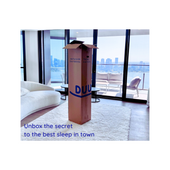Co-sleeping, where parents share a bed with their baby, is a practice that has been embraced by many cultures around the world.
However, it remains a topic of debate among parents and health professionals, particularly in Australia.
Should parents co-sleep with their babies?
What is Co-Sleeping?
Co-sleeping refers to parents and babies sleeping in close proximity, typically in the same bed.
It contrasts with solitary sleeping, where the baby sleeps in a separate crib or room.
Co-sleeping can take various forms, including bed-sharing, room-sharing, and using co-sleeping devices attached to the parents' bed.
Benefits of Co-Sleeping
1. Enhanced Bonding and Emotional Security
One of the primary benefits of co-sleeping is the enhanced bonding between parents and their baby.
Proximity during sleep can foster a sense of security and attachment, which is crucial for the baby’s emotional development.
Many parents find that co-sleeping helps them feel more connected to their baby.
2. Easier Nighttime Feeding
For breastfeeding mothers, co-sleeping can make nighttime feedings more convenient.
Being close to the baby reduces the need for the mother to get out of bed, leading to more restful nights.
This can be particularly beneficial in the early months when babies feed frequently.
3. Improved Sleep for Parents and Baby
Some parents report that both they and their baby sleep better when co-sleeping.
The baby may wake less frequently and settle more easily when they sense the presence of their parents.
This can result in longer stretches of uninterrupted sleep for everyone involved.
4. Cultural and Familial Practices
In many cultures, co-sleeping is a traditional practice passed down through generations.
It aligns with familial norms and values, making it a natural choice for many parents.
Embracing co-sleeping can be a way to maintain cultural continuity and honor family traditions.
Drawbacks of Co-Sleeping
1. Safety Concerns
The most significant concern with co-sleeping is safety.
Bed-sharing has been associated with an increased risk of Sudden Infant Death Syndrome (SIDS) and accidental suffocation.
The risk factors include soft bedding, parental smoking, alcohol consumption, and overheating.
Parents must be aware of these risks and take precautions to create a safe sleep environment.
2. Sleep Disruptions
While some families find co-sleeping beneficial, others experience frequent sleep disruptions.
Babies may move around, cry, or need to be comforted, which can disturb the parents’ sleep.
Over time, this can lead to sleep deprivation and associated health issues.
3. Impact on Parental Relationship
Sharing a bed with a baby can affect the parents’ relationship.
The lack of privacy and reduced space for intimacy may strain the relationship.
Couples need to communicate and find ways to maintain their connection while co-sleeping.
4. Transition Challenges
Transitioning a baby from co-sleeping to independent sleeping can be challenging.
Babies who are used to sleeping with their parents may resist moving to their own crib or room, leading to prolonged bedtime struggles and sleep disturbances.
Expert Opinions and Recommendations
Health organisations and experts have varying opinions on co-sleeping.
The American Academy of Pediatrics (AAP) advises against bed-sharing but supports room-sharing as a safer alternative.
Room-sharing involves placing the baby’s crib in the parents’ room, allowing close proximity without the risks associated with bed-sharing.
In Western Australia, health professionals echo these sentiments, emphasizing the importance of creating a safe sleep environment.
Dr. Emily Brown, a pediatrician based in Perth, states, "While co-sleeping can offer benefits, parents must prioritize safety. Room-sharing is a practical compromise that provides closeness while reducing risks."
Creating a Safe Co-Sleeping Environment
For parents who choose to co-sleep, taking steps to ensure safety is paramount. Here are some guidelines to consider:
- Use a Firm Mattress: Ensure the mattress is firm and free of soft bedding, pillows, and toys.
- Avoid Overheating: Dress the baby in appropriate sleepwear and keep the room at a comfortable temperature.
- Non-Smoking Environment: Ensure that no one in the household smokes, as exposure to smoke increases SIDS risk.
- Safe Sleep Position: Always place the baby on their back to sleep, never on their stomach or side.
- Limit Alcohol and Medications: Parents should avoid alcohol and medications that can impair their awareness and responsiveness.
Co-sleeping is a personal decision that comes with both benefits and drawbacks.
Enhanced bonding, easier nighttime feeding, and improved sleep are significant advantages, while safety concerns, sleep disruptions, and potential relationship impacts are notable drawbacks.
Parents in Australia should weigh these factors carefully and consult with healthcare professionals to make informed choices that align with their family’s needs and values.
Whether you choose to co-sleep or adopt alternative sleep arrangements, the priority should always be the safety and well-being of the baby.
By understanding the risks and benefits, parents can create a sleep environment that supports healthy development and peaceful nights for the whole family.

















































